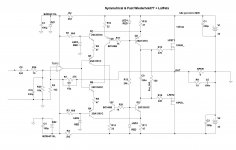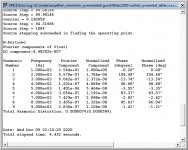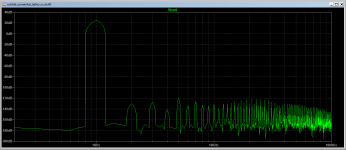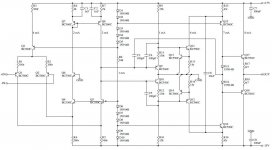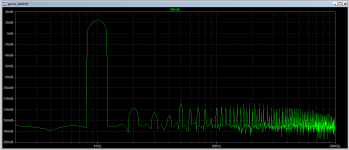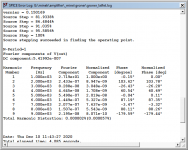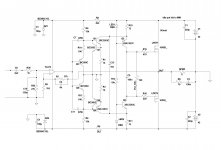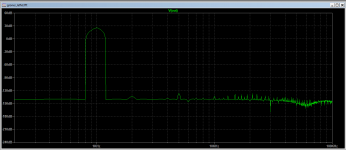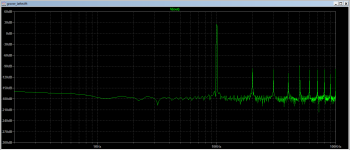kicad and DipTrace /
There are free versions. In Kikad, it is good to watch gerberas from Sprint Laut.
There are free versions. In Kikad, it is good to watch gerberas from Sprint Laut.
Last edited:
They are free, but much harder to use than Sprint Layout.
Good things in life don't come free (except Linux) 🙂
Good things in life don't come free (except Linux) 🙂
Here is another attempt, so far I think giving the best results (symmetrical without inductors 🙂 )
Basically this is Wiederhold, with slightly different biasing, and CCS added to keep symmetry as even as possible. Without the CCS, symmetry was questionable at best...
From what I see, square waves always look good/acceptable in most of simulations we posted here so far, if output is below 30Vpp.
Real problems to smooth them out, and keep rise time low at the same time, show up only at higher amplitude of input signal (E.g. output Vpp = 50V).
In .asc file R6/R8 have small caps added to smooth square waves
at 50V amplitude (not shown in the jpg image).
Diodes biasing Q1/Q4 must be LEDs, not 1n4148.
Slew Rate is approx 50..60 V/us
Basically this is Wiederhold, with slightly different biasing, and CCS added to keep symmetry as even as possible. Without the CCS, symmetry was questionable at best...
From what I see, square waves always look good/acceptable in most of simulations we posted here so far, if output is below 30Vpp.
Real problems to smooth them out, and keep rise time low at the same time, show up only at higher amplitude of input signal (E.g. output Vpp = 50V).
In .asc file R6/R8 have small caps added to smooth square waves
at 50V amplitude (not shown in the jpg image).
Diodes biasing Q1/Q4 must be LEDs, not 1n4148.
Slew Rate is approx 50..60 V/us
Attachments
Check the clip on the amp output and the op amp output.
In fact, there is no speed higher than 20 V / microseconds in sound
In fact, there is no speed higher than 20 V / microseconds in sound
Last edited:
Check ac coupled input distortion.
You will find something near to 0.005%. It means your input load resistence R20 is too low or you need a bigger C8
You will find something near to 0.005%. It means your input load resistence R20 is too low or you need a bigger C8
Last edited:
>Check ac coupled input distortion.
With sufficiently big input cap, these distortions disappear.
With sufficiently big input cap, these distortions disappear.
Last edited:
Groner's amp
Here is something new - Samuel Groner's topology, with input LTP replaced by opamp. Looks almost like Wiederhold 🙂
Groner's article is available on Linear Audio ($$), and there was some discussion here, on DIYAudio:
Samuel Groner's New Audio Amplifier Topology Article
Looks quiet promising.. Square waves also OK.
Here is something new - Samuel Groner's topology, with input LTP replaced by opamp. Looks almost like Wiederhold 🙂
Groner's article is available on Linear Audio ($$), and there was some discussion here, on DIYAudio:
Samuel Groner's New Audio Amplifier Topology Article
Looks quiet promising.. Square waves also OK.
Attachments
>In fact, there is no speed higher than 20 V / microseconds in sound
1stly - that depends on the output power, and bandwidth. What you said is true for 100W, 20kHz amp.
2ndly - there are lots of subjective opinions that faster amps sound better, and there is some questionable(?) theory explaining why...
So why not try it?
1stly - that depends on the output power, and bandwidth. What you said is true for 100W, 20kHz amp.
2ndly - there are lots of subjective opinions that faster amps sound better, and there is some questionable(?) theory explaining why...
So why not try it?
Last edited:
Previous symmetrical versions of LP never simmed right for me..
Either slow, or square waves not good.
This one also gives slightly better numbers/graphs.
Either slow, or square waves not good.
This one also gives slightly better numbers/graphs.
Last edited:
The spectrum relative to 1 kHz and the band up to 100 kHz mean nothing. Better a 10 kHz main tone and a 100 kHz band graph and cut out at the bottom of 500-600 Hz.Then the graph is informative
- Home
- Amplifiers
- Solid State
- Unusual amp from 1987
